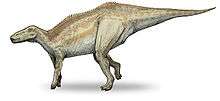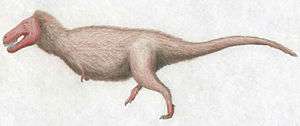Xingezhuang Formation
| Xingezhuang Formation Stratigraphic range: Late Cretaceous, 70 Ma | |
|---|---|
| Type | Geological Formation |
| Location | |
| Country | China |
The Xingezhuang Formation is an Upper Cretaceous fossil bearing rock formation in China. It is located near Zhucheng, in the province of Shandong.[1]
Dinosaur finds
Ceratopsians
Color key
|
Notes Uncertain or tentative taxa are in small text; |
| Genus | Species | Location | Member | Material | Notes | Images |
|---|---|---|---|---|---|---|
|
S. zhuchengensis |
N/A |
N/A |
Partial skull. |
A pachyrhinosaurin centrosaurine ceratopsid that could grow up to an estimated 6 m (19.7 ft) length and 2 meters (6.6 ft) height, and weigh up to 2 tons (2.0 long tons; 2.2 short tons). It is the first discovered Asian ceratopsid. It has a short, hooked horn on its nose (called a nasal horn), no horns above its eyes (brow horns), and a short neck frill with a series of forward-curving hornlets that gave the frill a crown-like appearance. Inside this row of hornlets there is a series of low knobs on the top of the frill, which are not seen in any other horned dinosaur. skull of Sinoceratops is estimated to be 180 cm (5.9 ft) long making it one of the largest known centrosaurine skulls. |
| |
Other
Color key
|
Notes Uncertain or tentative taxa are in small text; |
| Genus | Species | Location | Member | Material | Notes | Images |
|---|---|---|---|---|---|---|
|
H. aigahtens |
N/A |
N/A |
Fairly complete skeleton with skull. |
A saurolophine hadrosaur with estimated dimensions including a length of 18.7 meters (61 ft) and a height of 11.3 meters (37 ft) (in a tripodal posture), making it one of the largest ornithopods known. Most likely it is synonymous with Shantungosaurus. |
| |
|
S. giganteus |
N/A |
N/A |
A fairly complete skeleton. |
An edmontosaurin saurolophine hadrosaur that is among the largest ornithischians ever to exist, measuring 14.7 meters (48 ft) to 16.6 meters (54 ft) in length. A large hole near its nostrils may have been covered by a loose flap, which could be inflated to make sounds. |
Theropods
Color key
|
Notes Uncertain or tentative taxa are in small text; |
| Genus | Species | Location | Member | Material | Notes | Images |
|---|---|---|---|---|---|---|
|
Z. magnus |
Shandong, China |
Wangshi Series |
A partial skull |
A tyrannosaurine tyrannosaurid estimated to have been 10–12 m (33–39 ft) in length and up to 6 short tons (5.4 t) in weight. Zhuchengtyrannus can be distinguished from all other tyrannosaurines by a single autapomorphy, the presence of a horizontal shelf on the lateral surface of the base of the ascending process of the maxilla, and a rounded notch in the anterior margin of the maxillary fenestra. Zhuchengtyrannus also possesses a ventral margin of the antorbital fenestra that lies well above that of the ventral rim of the antorbital fossa. Additionally, the total length of the maxillary fenestra is more than half the distance between the anterior margins of the antorbital fossa and fenestra. Unlike the contemporaneous Tarbosaurus, Zhuchengtyrannus lacks a subcutaneous flange on the posterodorsal part of the jugal ramus of the maxilla, and a ventrally convex palatal shelf that covers the bulges of the roots of the rear teeth in medial view. |
||
See also
References
- ↑ Zhao Xijin, Wang Kebai, & Li Dunjing. (2011). "Huaxiaosaurus aigahtens." Geological Bulletin of China 30 (11):1671-1688
- ↑ Mortimer, M. "Tyrannosauridae". Theropod Database. Archived from the original on September 29, 2013.
| Cretaceous Period | |
|---|---|
| Lower/Early Cretaceous | Upper/Late Cretaceous |
| Berriasian | Valanginian | Hauterivian Barremian| Aptian | Albian |
Cenomanian | Turonian | Coniacian Santonian |Campanian | Maastrichtian |


